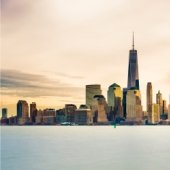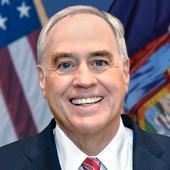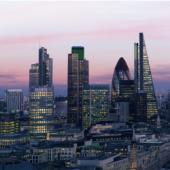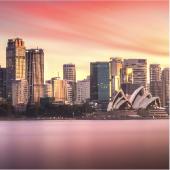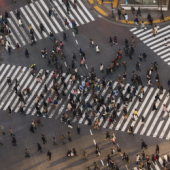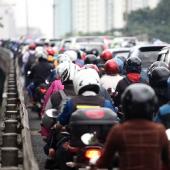Greg Lindsay on the way we live next
IN BRIEF
- 1:53 – How real is the remote work revolution? “I think it’s a good thing for cities that we are seeing employers returning and not throwing away their real estate portfolios as some of those CEOs threatened to do early on.”
- 6:00 – A Cambrian explosion of new types of devices: “The real use case for autonomy is not going to be the self-driving car but rather this new type of species for urban robotics for delivery, for conveyance of things, personal scooters… The idea that you walk out of a building and tap a button and a personal vehicle of any size will come to you is really powerful.”
- 14:20 – Optimism about cities in 2030: “Cities survived the pandemic. They survived every pandemic before that, but they survived a pandemic coupled with the technology that for 50 years we thought would render cities obsolete.”
Is suburban commercial real estate dying out? How do we solve climate change for the “bottom one billion”? And will the French ever love Champs-Élysées? In this podcast, Joe Kornik, Director of Brand Publishing and Editor-in-Chief of VISION by Protiviti is joined by Greg Lindsay, a senior fellow at NewCities, Director of Strategy for LA CoMotion, and a visiting scholar at New York University’s Rudin Center for Transportation Policy and Management, to discuss these questions and more. Greg is a futurist, urbanist, author, journalist, and all-around expert in how cities of tomorrow will look, feel and function.
GREG LINDSAY ON THE WAY WE LIVE NEXT - Audio transcript
Joe Kornik: Welcome to the VISION by Protiviti podcast. I’m Joe Kornik, Director of Brand Publishing and Editor-in-Chief of VISION by Protiviti, our new quarterly content initiative where we put megatrends under the microscope and look far into the future to examine the strategic implications of big topics that will impact the C-suite and executive boardrooms worldwide. In this, our first topic, “The Future of Cities,” we’re exploring the evolution urban areas are undergoing post-COVID and how those changes will alter cities over the next decade and beyond. Today, we’re joined by Greg Lindsay, a senior fellow at NewCities and also Director of Strategy for LA CoMotion — an annual mobility festival in Los Angeles — and a visiting scholar at New York University’s Rudin Center for Transportation Policy and Management. Greg is a futurist, urbanist, author, journalist, and all-around expert in how cities of tomorrow will look, feel and function. Greg, so great to have you here. Thanks so much for joining me today.
Greg Lindsay: Thanks for having me.
Kornik: Greg, as we begin to rethink cities and their futures, there are a few big issues that sort of come to mind for me. Trends that probably were happening but were probably accelerated by COVID, I would say, and one of those trends that I think we need to take a deeper look at is around real estate. People with means left cities during COVID. That was well-documented. And obviously, companies shuttered offices in favor of remote work. I think one of the biggest stories about cities post-COVID and the future of cities is really about real estate, both commercial and residential, and of course the tax base that it represents for cities. I know you’ve done lots of work in that space with Brookfield Properties and others, so I’d love your take on what you sort of see in the urban real estate market and about how those shifting demographics could impact it going forward.
Lindsay: Well, you know the truth is, it’s still a little early to tell, because the big question is “How real is the remote work revolution?” We’re seeing right now, in the States in the particular, the companies want them back. Jamie Dimon canceling all of his Zoom meetings because he’s “over it,” [Laughter] but a lot of workers still want to have that kind of flexibility. They’ve gotten used to this lifestyle. I think it’s going to be a lot of butting of heads and experiments that will have to play out before we sort of see where that goes.
But I do think it’s a good thing for cities that we are seeing employers return to that and not throwing away their real estate portfolios as some of those bankers, CEOs threatened to do early on. But it will raise really interesting questions about, “Will we need as much office space?” If so, what does that do to the valuations of that which has, of course, implications for the tax base and for cities? What will the conversations be? That, to me, is a really interesting area about, can we convert some of that Manhattan real estate into the housing New York desperately needs and the Bay Area desperately needs. Will we see new types of mixed-use real estate?
If I have to choose a category type that I think is deader than dead, and it was already pretty dead, it was the suburban office park. Like, why would you ever go to a suburban office park? Even if you live there, stay at home. [Laughter] So, it will be really interesting to see whether that die-off of commercial real estate happens, not in the center of cities as people thought a year ago, but would really happen in sort of the ex-urban fringe and whether that can pose an opportunity to build more walkable places that people like. There’s a whole body of literature that showed before the pandemic, real estate premiums accruing to places that were walkable or bikeable or that have those kinds of amenities to it. So, I think that’s really interesting. I personally suspect that people will rekindle their love affair with cities. That they’re going to find that being at home all day in the suburbs is going to lose its charm. We’re already seeing studies, for example, showing that traffic is way up in the afternoons, totally predictable. All of those trips that you could take on foot in the middle of Manhattan or any other city near an office, you’re now doing in your car at that level of scale, and that traffic adds up. So, it will be interesting to see.
But yes, I think the really important thing in the short-term, with the Biden administration and others, is that we make sure that transit systems and the other sort of things that keep cities going don’t suffer huge permanent cutback in service and lose riders because, otherwise, that’s going to have cascading effects going forward.
Kornik: To your point, we’re social creatures, right? We want to be out amongst each other, we don’t want to be cooped up in our houses on Zoom calls all day. It’s clearly getting old. I’m glad you mentioned transit, because I do think that another key piece of the future of cities’ puzzle is around mobility, specifically sort of autonomous and connected mobility. I know you’ve done some work in this area with Toyota and some other companies. I find this fascinating, that soon we could have sort of autonomous drones, or flying taxis, I guess, is the non-fancy way of saying that, sort of buzzing around cities and maybe over 160-year-old underground in London or over the 120-year-old subway system in Manhattan, which I just find a really interesting dichotomy there. So, help me wrap my head around sort of mobility and the future of mobility as we talk about specifically, obviously, urban mobility. Help me wrap my head around that.
Lindsay: One thing we’d say for certain is the future is electric, right? This massive surge towards EVs. The Ford F-150 Lightning I am seeing now described as the potential real game changer. Solving all the cultural issues, having all of that incredible battery power that you can use to decentralize the grid and push for renewables. So, that’s really interesting there. Yes, the big question mark is, again, sort of the public transit in the backbone of cities and how they suffer the most during this while people with means fled to their suburban homes and bought cars and bought them in droves. So, I think that’s really interesting.
But yes, I’m more focused I think particularly on the revolution and personal electric mobility. It’s happening in Europe more than in the States. Germany, I think more than 10% of households now have electric bicycles. The French, huge adoption during the pandemic of this. Forward-thinking cities like Paris, Milan, Madrid and others, they had personal subsidies. You can get up to €1,000 to buy an e-Bike or a scooter, they put investments in bike lanes. Those cities made it a lot more attractive and could reduce their reliance on cars while you didn’t have to travel in the subway, which was safe the whole time I should add.
I think that’s a really interesting thing going forward because this gets back to the larger trend of what I think is exciting, as you said, about micromobility and robotics there, is that like for 70-80 years, we had one foreign factor that dominated the car, and now we have this Cambrian explosion of new types of devices. I think, for example, the real use case for autonomy, which, when you get down to it, it’s a camera, LIDAR sensors that get cheaper over time. It’s not going to be a self-driving car, it’s going to be this whole new types of species, of urban robotics for delivery, for conveyance of things. I think autonomous scooters are actually going to be really interesting. I’ve seen a handful of prototypes by Tortoise and others. The notion that you could walk out of a building and with a tap of a button, your own personal vehicle could come to you, of any size that you can use, I think is really powerful.
The one thing I’m a little uncertain on right now is the urban air mobility as I think we call it there, UAM. To me, the most interesting question about that will be the NIMBYs, right? We, once upon a time, we’re going to have supersonic transport in this world and we shot it down because of noise worries. No one’s figured out how to make a drone quiet yet. I know in Los Angeles, which is really the frontier of helicopters and UAM in the States, people hate that for the noise variations. So, I think this is going to be a really interesting challenge about that confluence of real estate, and neighbors, and law that hasn’t been figured out yet, even if the tech gets mature enough, which it increasingly is. So, we’ll see. The one thing I’m pretty sure, it’s not hyperloop. I don’t see the point of building giant steel tubes on the ground when you can just as easily get on a plane or take a train.
Kornik: Right. I guess it would be not in my backyard airspace, I guess, is we’d have to add an AS to the end of NIMBYs, right? Yes, that’s interesting. One other area I think as we get into these renewables, and cities will obviously have to adjust, because how the infrastructure is set up will determine a lot on how people will get around cities. With the renewables and with a lot of the things that we just discussed, there are, obviously, climate impacts and sustainability issues, which I think would be a huge win for a lot of those electric vehicles that you just mentioned. We’ve already seen some people in cities, and indeed, some cities themselves sort of being forced to relocate because those places may soon be unlivable. I mean, when we talk about climate change and the ultimate impacts it could have. So, take me through a little of what you see on the climate front in cities for the next decade. Let’s say 2030, 2040, and even 2050, if you want to go that far out.
Lindsay: Well, I’d say I think the changing climate still is one of the great cognitive dissonances of our time, like this notion that we’re going to be able to adapt and mitigate to survive in almost any climate. I think it’s admirable what a lot of cities are doing in terms of decarbonizing. I just saw that Des Moines, I think, wants to take out every fossil fuel out of its urban grid mix by 2035. I think we’ll see a lot more push for that. But the real question, which is really the one that public officials don’t want to have is, is that we can’t save every place, right? The sea levels will rise, the wildfires will burn, the extreme heat will get hotter, and we’re going to have make tough choices. Tough choice is not about telling you were to live at least, but where you want to invest, right? Like if we’re going to invest $2.25 trillion, like the Biden administration wants to do, should we be putting that in Miami or should we be putting that in wildfire zones? We already see the insurance industry, for example, desperately wants to drop policies in Central California and the state won’t let them, and all sorts of problems with the national flood insurance program as well.
I don’t know. It’s a really tough conversation, and one I’ve tried to convene several times in my work, and on one really wants to talk about it other than sort of the planners who are concerned, and about wealthy people will leave just like they left during the pandemic for those suburban homes. Wealthy people will pick up and they will buy real estate in Burlington, Vermont or some of those upstate towns that many New Yorkers move to, where the land is attractive and will only get more so. But what about those who are left behind, how do we help those communities that will suddenly, all at once, get much poorer as property values drop and so forth?
So, we need to create more programs like that, I think, in the States. And globally, about thinking about where should people move? What are the mechanisms to steer them away? Insurance and market incentives are one thing, but hopefully, we can delineate some of those risks.
Now, by 2030, I’m not sure it will be in place there, but I think it’s going to become more and more apparent. Heat waves will be more often, and I think the biggest threat that is posed to San Francisco and also some of the cities in the Pacific Northwest, is that despite how great their climate is overall, if you’re a family and you have to spend a week or two each year indoors with air filters because the wildfires are burning, people are going to vote with their feet, and that will affect the long-term consequences for those cities, which at one point last year, by the way, I think Vancouver, Portland, and Seattle were all the most polluted cities on Earth for at least a week during the wildfire season.
Kornik: Crazy. And it’s going to have sweeping impacts as we go forward. I think it’s hard for people to focus — it’s hard to focus two years out, let alone 10 years or even more — 30, 40, 50 years out for some of these things. But certainly, it will be a very different globe, I think, in 2050 and beyond. What we are seeing is sort of these new cities from scratch that are sort of popping up all over. Talk about a place that’s really a difficult place to live from a climate perspective. There’s a city called Neom in Saudi Arabia that’s sort of a prime example that’s launching, and they have something called The Line. It’s sort of an energy-efficient city, it’s going to be carbon neutral from the jump. So, this is a complete change of sort of how cities have evolved and been built slowly over hundreds and even thousands of years. What do you make of these sorts of reverse-engineered cities that we’ll continue to see — will we continue to see more of this type of development happening, and will we see any of it happening in sort of our more established world’s-greatest-cities that we’ve come to know and love?
Lindsay: Yes, Neom is a fascinating project. Right? It’s like the total climax of the Dubai model of development and creating its own special legal zone in addition to the technology described. I do like the fact that The Line, which is literally a line that will preserve most of the site’s wilderness, will have a spine that’s going to be hyperloop or high-speed rail, but every neighborhood will be a so-called five-minute city. So, I think it’s really interesting. They’re trying to basically use remote work and personal transport and these systems and keep it together. I would be very curious if they can make that workable.
But yes, I’ve been studying instant cities for more than a decade and find them fascinating on multiple levels. One of which is like, just how hard it is to build a city. No matter how much time and effort a team of architects and engineers can put into it, they can still never replicate that lived-in feeling because you just need so many little hands about it. But yes, I mean — before Neom, there was Songdo in South Korea, which is also aimed to be the world’s most sustainable city, and did some great work in integrating the systems together. I think what these instant cities are best at are — yes, they’re prototypes. They’re prototypes for what you can achieve if you network all the bits and pieces of technology together that work well on their own, like district heating and cooling, and various films you can put on office windows to basically reduce energy loss, and — you know, this whole checklist. Songdo has pneumatic tubes for waste collection and burning into clean electricity for example.
The larger problem is that as fast as these cities get built, they don’t get built fast enough. We call them “instant cities,” but when I visited Songdo, there was a sprawl all the way around the urban edge that popped up long before they ever even broke ground on the sustainable district. So, it kind of underscores that urbanization is going to happen much faster than any of these prototype cities can do, and I think that’s why it’s important that at the same time we pursue these, we needed to think long and hard about how do we build like an open source kit of parts for the bottom billion? For the people who are hand-building their homes and cities in what we would call slums, but of course, [Unintelligible] and all these great cities around the world that are often in the most crucial real estate, right?
Dharavi, the largest slum in India, is in the middle of Mumbai. But how do we get solar panels to them? How do we give them sustainable building materials and do it so cheaply so these people can do that for themselves? I think that’s one of the critical challenges as well. Figuring out what that prototype kit of parts looks like at the bottom as well as the top.
Kornik: Yes, interesting. That clearly will be an indicator of where we go, right? How we sort of take care of the bottom billion, as you refer to them. Okay, so let’s talk a little bit about where we’re going. Time to put on sort of the futurist hat, if you will. Take me to 2030 and even further out you’d like. Give me a few thoughts about what cities will we — a decade from now, or like I said, even further out, how will they be different, what might surprise me, what’s going to catch me off guard, and ultimately, will they still be viable and dynamic places to live and work? I mean, how optimistic are you on sort of the long-term future of cities?
Lindsay: I’m, ultimately, I guess more bullish than I ever have been, ironically. They survived the pandemic. I mean, it survived every pandemic before that, but they survived a pandemic coupled with the technology that for 50 years, we thought would render cities obsolete. Like Alvin Toffler, Marshall McLuhan, they all predicted the death of cities because of the kind of remote work tech that we have now, and it still hasn’t happened. At this point, I don’t know what could kill cities. Perhaps there will be rising seas or fires.
But you know, if you want to talk 2030, I could give you a specific vision, and I will just have to paint it for you because this is a podcast and we don’t have images [Laughter] for once. I was part of a team of architects that is redesigning the Champs-Elysees in Paris, and what’s really interesting about this project is that it started before the pandemic or any of these trends, it started because Parisians hate the Champs-Elysees. It’s populated purely by tourists.
So, the challenge was how do we create a boulevard that Parisians will love? My friend, Philippe Chiambaretta, I was one of his mobility consultants. We took out the cars much as we can. We put in — imagine autonomous shuttles, and micromobility, and pedestrians. We expanded the tree cover and the cafés, and sort of reinvented it as a place for Parisians, which I think is a really interesting trend post-pandemic as well, because we’ve all kind of realized like how much of our cities are designed for global tourism and designed for global travelers. Like Times Square, utterly useless in a pandemic as it turns out. How can we rethink that?
So, I think it’s a really interesting example because, yes, we imagine a place that’s more human, that’s more walkable, that’s more inviting to people. Philippe describes his goal as re-enchanting the Champs-Elysees. So, perhaps by 2030, we’ll see, at least the world’s most successful cities, will have re-enchanted themselves, investing in that kind of infrastructure for people that will draw them to cities. Because if you can work from anywhere, then you’re going to have to have a reason to want to be there. And then for everyone else, I think it’s an open question.
I mean, I look at Dubai as really the sort of example of where we’ve stretched global urbanism. A city that’s put together more by code and nodes there of living in one district and working in another, and all sort of bound together. I think Miami is sort of going that route right now too, with all the tech bros moving there from Silicon Valley. Will people choose cities that have warm beaches, low tax rates, and a climate that’s great now but not so good in the future? Will people move more north as we start to see climate change?
That’s one of the reason I live in Montreal. I’ve explicitly thought about this and written about this. And yes, I think if there’s one thing we could think about in 2030, is that we’ll all be thinking a lot harder about where we live and why we live in cities. We’re no longer going to take this for granted. I think we’ll see in the United States, a wave of migration that has not existed in decades. Americans have moved less and less over line and now as they can re-emerge, they’re going to reevaluate their life choices. And yes, I think we can be certain that’s going to happen a lot in the rest of the world as well. We’re going to see waves of migration, and the most successful cities will be the ones that can handle that wave and be able to be invited into their residence. I think that will occupy us at least until the middle of the century.
Kornik: Yes, fascinating stuff. It’s interesting to think that far out and think about cities. That’s what, two-thirds, if not, three-quarters of the world’s population will end up in a city in the next decade or so. That’s our future. I mean, cities’ future is humanity’s future essentially. So, Greg, great stuff. Thank you so much for taking the time to be with me today, and fascinating conversation. I appreciate it.
Lindsay: Thank you so much for having me.
Kornik: Thanks for listening to the VISION by Protiviti podcast. Please rate and subscribe wherever you listen to podcasts, and visit us at vision.protiviti.com.
Greg Lindsay is a senior fellow at NewCities, where he has explored the future of connected mobility and mixed-use development on behalf of Toyota and Brookfield Properties, respectively. He is also a non-resident senior fellow at the Atlantic Council’s Foresight, Strategy and Risks Initiative, where he studies the intersection of cities, technology, climate change, and national security.
Did you enjoy this content? For more like this, subscribe to the VISION by Protiviti newsletter.






